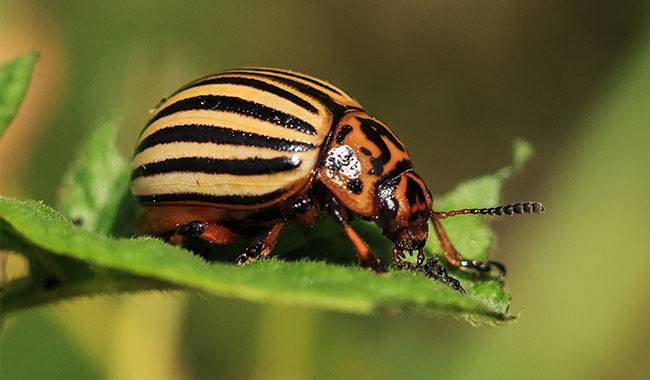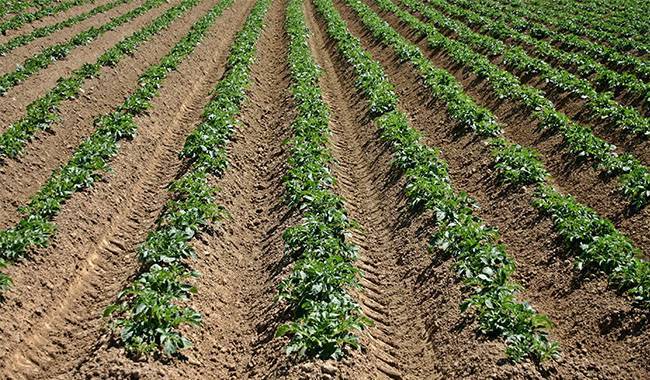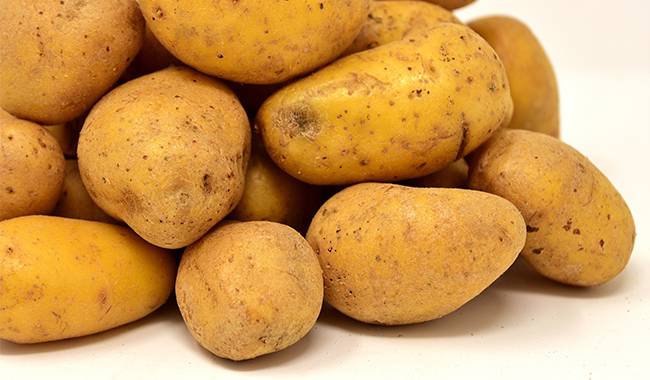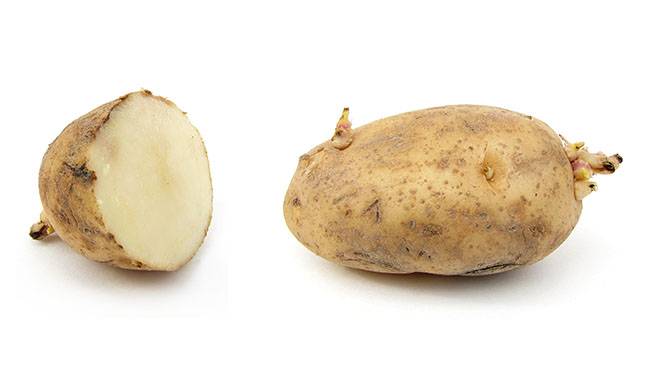
Potatoes are a second bread which can be cook in many dishes. Some of the respected gourmets in particular even add fresh diced potatoes to their salads.
But to get a good crop of potatoes, you must choose your tubers correctly, prepare them for planting, and treat them properly before planting and caring for them.
Today, we will talk about proper pre-sprouting potatoes before planting.
CALIBRATION OF POTATO TUBERS BEFORE PLANTING
The first step in preparing potato tubers for planting is to calibrate them and also to check them for any rot or other damage. Thus, if a potato tuber has started to rot, it is important to cut that part off and burn it, while the exposed potato core is best covered with charcoal, but it can also be covered with wood ash.
Some are treated with a weak pink manganese solution, which can be treated with a 1% Bordeaux mixture or copper alum solution, and spraying with Ebenezer or zircon solution is also acceptable, then allowing the cut section to dry and form a crust. If this is not done, some potatoes may rot in the soil, especially in rainy summer conditions.
Next comes calibration – tubers are usually divided into those over one hundred grams, such tubers are best cut in half when planted, after doing all the above procedures, then go for those weighing about 60 to 90 grams, which can be planted whole, and those below forty grams, which are best planted in a separate place, where they can go to feed livestock or be used for other types of processing if there will be a weak harvest.
When cutting large potatoes, remember that it is better not to cut them horizontally, but exactly lengthwise, so that both sides of the tuber will have about the same number of shots. Place the split tubers in the soil with the cut part of the tuber facing downward.
PLANTING POTATOES BEFORE PLANTING
The second step before sowing potato tubers is to green them. There is nothing complicated about this, except that they are spread out in layers in the light, and when one tuber turns dark green, all of them are turned over with another tuber to turn completely green. These tubers accumulate large amounts of lycopene and should not be eaten, but they germinate more quickly and are usually friendlier and stronger after germination.
SPROUTING POTATO TUBERS BEFORE PLANTING
The next step is to sprout the potatoes. When a good farmer puts their potato seeds in a sandpit and doesn’t start germinating them until after they have germinated themselves, it’s a good way to ensure a good harvest.
Sometimes the whole secret is that the potatoes used for sowing, i.e. the seed potatoes, are stored in a separate barn, or even a separate room, at a constant temperature of four degrees above zero. At this temperature, the tubers “sleep” and no growth process takes place.
HOW LONG DO TUBERS HAVE BEFORE THEY GERMINATE
Normally, the tubers are removed from the seed potato storage about 15 days before planting into the ground for germination. This is usually enough time for tuber seeds to grow full buds about 0.4inch (1cm) long. Seedlings may be smaller, which will delay germination a bit, but if they are larger, they may break during planting and germination will then be delayed for a long time.
CONDITIONS FOR POTATO TUBER GERMINATION
For rapid germination of tubers, they need to be placed in a sunny spot and on the floor, covered with burlap, at a temperature of 66-70°F (19-21°C) within a week.
Once new shoots begin to appear, the potatoes should be very carefully moved to a cooler place with temperatures between 50-57°F (11-14°C). It is under these conditions that you should wait for the seedlings to emerge.
It is perfectly acceptable to germinate potatoes in an ordinary wooden box – this is done when there is no space to spread the potatoes evenly. The temperature conditions are the same, but in this case, it will be more difficult to monitor the length of the sprouted seedlings.
WHAT TO DO IF POTATO TUBERS SPROUT EARLY?
What happens when, as it happens, the gardener opens the storage and the potato seeds have already sprouted, quite a bit before sowing? There are three options here – either cut off all the shoots and wait for germination after planting (only at a later stage), or cut off all the shoots so that they are 0.4inch (1cm) long and cover the cut with charcoal or buy new seeds, as there is less hope of getting a good crop from such tubers than from normal tubers. You can grow sprouted potatoes “as is” and wait to see what happens.
TREATMENT OF POTATO TUBERS BEFORE PLANTING
Once the tubers have been selected, calibrated, cut as needed, the rotten centers removed, and they have turned green in the sun and sprouted shoots about 0.4inch (1cm) long, it is time to move on to the last but very important pre-planting stage – pest and disease control of the tubers.
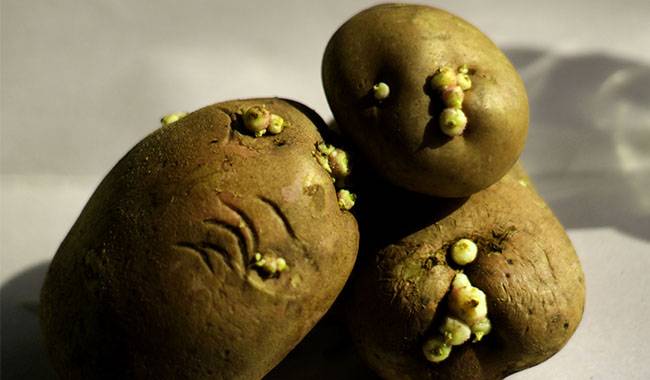
SPRAYING TUBERS WITH NEMATODE AND POTATO BEETLE CONTROL
Wireworms and potato beetles cause irreparable damage to potatoes, and both pests can completely destroy the crop, so it is necessary to treat tubers and control wireworms and potato beetles before planting.
It is permissible to apply insecticides to these pests, follow the instructions as closely as the current season allows, do not exceed the dose, and work in protective clothing – jacket, respirator, and long protective rubber gloves.
Tubers can be controlled with “premium insecticides”, which protect tubers and seedlings from nematodes during the growing season.
In the case of potato beetles, “local quality insecticides” usually provide protection for up to a month after the potato shoots appear on the soil surface. This is sometimes enough for the seedlings to become as strong as possible and able to defend themselves against potato beetles.
After this period, potatoes can be retreated by diluting the preparation exactly as directed on the package. You can treat both the plant itself and the soil beneath the plant. Remember that solutions for tuber treatment and plant treatment should be stored for only one day. Typically, gardeners dilute one gram of the preparation in a bucket of water, an amount sufficient to treat one percent of the land and the planted plants.
Potato tubers can be treated with a complex drug before planting, i.e. with insecticidal and fungicidal properties. This drug is usually diluted at a ratio of 1 to 20 and sprayed on all sides of the potatoes with a spray gun. One bag of the solution is enough to treat ten kilograms of potatoes or slightly more. After treatment, do not plant the potatoes immediately; they should be allowed to dry for a few hours and then can be planted in the soil.
Studies have found that “local quality insecticide” provides good protection for the tubers and above-ground parts of the potato plant against thrips, various pests, nematodes, leaf beetles, and sawflies, as well as against fungal diseases such as scab, rot, and powdery mildew.
For those who do not like to use chemicals, it is recommended to try planting mustard and any leguminous crops on the borders of the plot where the potatoes will be grown. This will protect the potatoes from these two pests.
TUBER TREATMENT TO PREVENT PHYLLOXERA
Phytophthora is the scourge of eggplant crops, so it is necessary to protect tubers from it at planting time as well. Various fungicides are often used to combat it, but safer solutions are also used. Such substances are also known as adaptogens, meaning that they mobilize and strengthen the potato’s immune system right at the tuber stage.
Insecticide fungicide stimulants” are usually applied to potatoes about 24 hours before planting. One one-milliliter ampoule is enough to treat about 50 tubers. Potam – also allows treatment of tubers 24 hours before sowing. Bioglobulin, – tubers are not treated with it and usually soaked with it for 30 minutes before planting. Also by soaking for one hour, allows bioglobulin to awaken and hard dormant potatoes.
Treatment with fungicides (prevention and treatment of plants from fungus). Do not be afraid of the name, fungicide (prevention and treatment of plants from fungus) is a biological agent that is very effective against fungal infections and can even prevent the development of bacterial infections.
Fungicide (prevention and treatment of plants against fungi) protects potato tubers from scab and rot after entering the soil and protects the above-ground parts from powdery mildew and phytophthora. In addition, any biological agent, including fungicides (prevention and treatment of plants against fungi), can help improve plant stress resistance.
Spraying tubers with fungicides (prevention and treatment of plants against fungi) is acceptable, both before the emergence of sprouts to activate their germination and before planting them in the soil, about 1.5-2.5 hours before.
The tubers can be soaked in a solution of fungicide (prevention and treatment of plants against fungi). Usually, fungicide (to prevent and treat plants against fungus) is sold in sachets, so usually half a sachet is dissolved in a liter of water and this amount is sprayed on 30-35 tubers.
Here are all the techniques you should know and perform before planting potato tubers in the ground. It will give you the highest yield from this cultivation.




